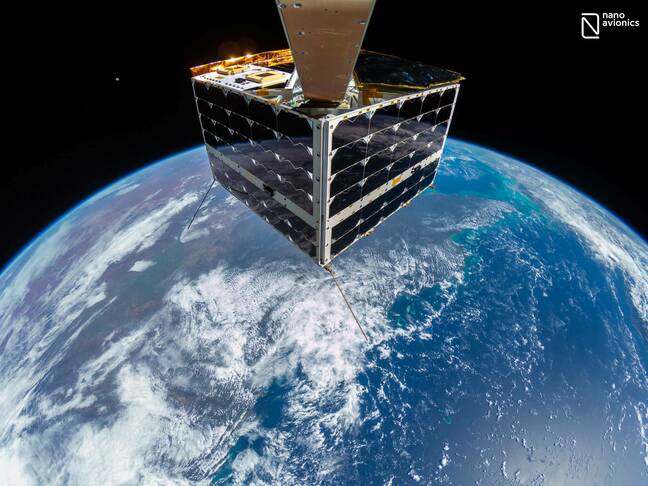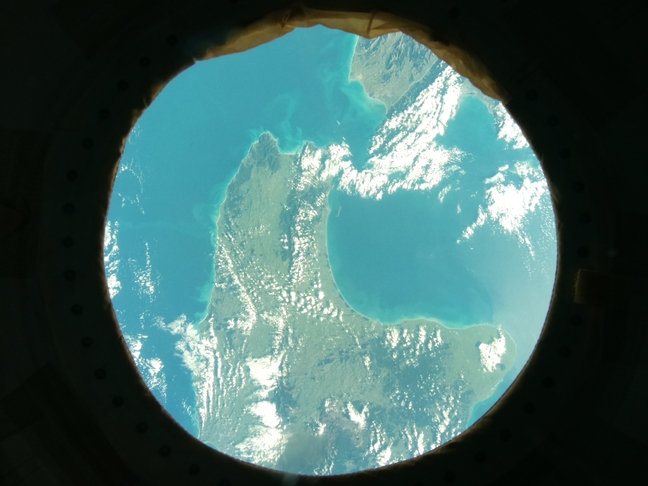Our #TECH_Newser covers ‘news of the day’ #techNewserTechnology content.
| cutline • press clip • news of the day |
NanoAvionics takes GoPro satellite selfie over Earth.
NanoAvionics has unveiled a 4K satellite selfie taken by a GoPro Hero 7 as the company’s MP42 microsatellite flew 550km above the Coral Sea and Great Barrier Reef.
Space selfies are hardly new. Buzz Aldrin snapped an image of himself during 1966’s Gemini 12 mission, and being able to get a picture of spacecraft can be invaluable when diagnosing issues.
The MP42 microsatellite was launched aboard a SpaceX Falcon 9 earlier this year and the camera (mounted on a space-grade selfie stick) sprung out to snap shots to demonstrate techniques to check for payload deployment, micrometeoroid impacts, and general fault detection.
And to also take some impressive shots of the spacecraft with Earth in the background.
The GoPro Hero 7 has had a few modifications to make it space-worthy. The device was stripped down and a custom housing made for its electronics. It had to undergo testing to ensure it would survive the vacuum and temperature swings experienced during orbit, and software was written so it could communicate with the spacecraft’s systems.
The MP42 features version 2.0 of the NanoAvionics Payload Controller. The hardware is Zynq-7015 SoC (with an Arm Cortex A9 processor) with 256KB of on-chip RAM and two banks of 512MB DDR3 RAM. It’ll take up to four microSD cards and the firmware can be updated while on orbit. The operating system is PetaLinux.
The consumer camera was selected since space-grade cameras tend to require months of development time and can be very expensive. The substantial chunks of data (both still and moving) generated by the hardware was also a handy way of demonstrating that the beefed-up Payload Controller 2.0 was capable of running running advanced applications needing to process large amounts of data.
“Transmitting several GB of images and videos when operating the camera with pre-programmed starts and stops from the ground was as data heavy as it gets,” said Ernestas Kalabuckas, chief technology officer of NanoAvionics.
Taking shots of Earth from space has taken on greater significance in recent years. As well as being a boon for environmental monitoring, satellite imagery has been used in tracking conflicts. While NanoAvionics’ microsatellites represent a relatively inexpensive way of getting to orbit, for ad hoc coders there are alternatives – the 12.3MP Raspberry Pi High Quality Camera springs to mind, which went to the International Space Station (ISS) with some new AstroPi units (Pi 4 Model Bs with 8GB this time) for the 2021/2022 European Astro Pi Challenge, which is an ESA Education project run in collaboration with the Raspberry Pi Foundation.
NanoAvionics is confident its satellite selfie stick and associated technology will prove useful as operators consider its uses. Vytenis J Buzas, co-founder and CEO of NanoAvionics, said: “In our increasingly visual culture, it is important for investors, students, customers, and the general public to see in order to believe. Millions watch rocket launches but barely see satellites moving in orbit or deployable structures in operation. This is going to change through live or recorded footage.” ®
‘News of the Day’ content, as reported by public domain newswires.
Source Information (if available)
It appears the above article may have originally appeared on www.theregister.com and has been shared elsewhere on the internet, repeatedly. News articles have become eerily similar to manufacturer descriptions.
We will happily entertain any content removal requests, simply reach out to us. In the interim, please perform due diligence and place any content you deem “privileged” behind a subscription and/or paywall.
First to share? If share image does not populate, please close the share box & re-open or reload page to load the image, Thanks!




